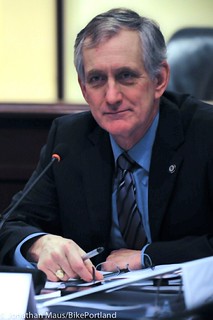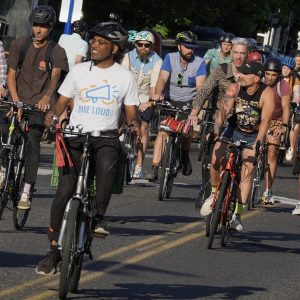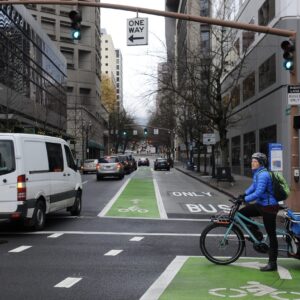At an event last night I was able to grab Mayor Charlies Hales for a few minutes to ask him for his thoughts on the major PBOT budget move that was unveiled yesterday.
At a City Council budget work session, Hales’ interim director of PBOT, Toby Widmer, unveiled a plan that would take $7.15 from existing budget items and put it all toward street paving and maintenance. Among the places Widmer “realigned resources” for more paving is a $1.2 million sidewalk project already funded and slated for construction this summer in East Portland on SE 136th between SE Powell and Holgate (about 0.52 miles). Another Widmer realignment victim is PBOT’s ADA curb ramp program which is being asked to give up $500,000. According to PBOT sources, that chunk equals about 30% of the entire program (which has annual budget of $1.7 million).
Asked about the proposal last night, Hales distanced himself from it. “It’s a bureau budget. It’s just a starting point.”
“No matter how thoughtful we are with the cuts, they will piss people off.”
What he’s referring to is the PBOT budget process. First, the bureau director submits the bureau’s budget as a request. Then, the Mayor makes final decisions before the budget is officially adopted. So, technically, Hales is right to make it seem like this is simply all the work of Toby Widmer and that he has yet to really get his hands dirty. However, that’s not entirely the situation this time around. Widmer, a former head of PBOT’s bureau of maintenance, was hand-picked by Mayor Hales specifically to re-focus the bureau on paving and maintenance. Also, Hales has taken all the bureaus under his wing and he’s been close to the transportation conversations since Day One. It’s highly unlikely Hales was not privvy to at least some details of Widmer’s proposal.
Even so, Hales told me last night he simply advised Widmer to find him the money to pave/maintain 100 miles of roads next year (and thus fulfill a publicly stated promise).
Specifically, about the cuts in the ADA ramp program, Hales said, “That was Toby’s idea. He looked at the cost-effectiveness of all the ramps we’re putting in. We can do less and still make progress. Simply carpet-bombing the city with access ramps isn’t the best expenditure of city dollars. You look at some ramps and you just scratch your head. It’s like really?! Who’s gonna’ use that?”
Turns out Hales and Widmer might be onto something here. From what I hear, the curb ramp program could indeed use a keener eye and the cuts being discussed won’t have a major impact. The reduction in ADA ramps will also still keep the City in compliance with the Americans with Disabilities Act that mandates the ramps. (Note: We have since learned the City is not in compliance with the ADA act; but that these cuts jibe with a previously agreed-upon plan to eventually become compliant. Sorry for any confusion.)
About the sidewalk project cut, Hales said that idea also emanated from Widmer and the bureau. “I didn’t craft that part of the proposal,” he said, “but I’m not unhappy with it.” Asked about the chances the sidewalk project cut would survive, Hales said, “I’d say it’s about 50/50 that the cut will remain.”
Hales then shared that, as he already experienced with his unpopular move to cut the Youth Connect summer program, the budget shortfalls faced by the City are so severe that he can’t avoid scorn. “This budget cycle, no matter how thoughtful we are, no matter how careful we are with the cuts, they will piss people off… The City is in a very tough spot. We can’t just sprinkle a little cut here and there and expect to get through this. It’s not going to be easy; but it’s not like we’re vindictive about it.”
Hales knows his decisions will be unpopular. “I’m willing to take whatever hits I have coming. I think this is the way forward and this is the way toward new revenue.”
“I’m willing to take whatever hits I have coming. I think this is the way forward and this is the way toward new revenue.”
I asked Mayor Hales how the new funding priority on paving will play out in the future. Is this a one-time thing or will he seek significant additional funds for paving and maintenance every year? “This commitment to maintenance is a must-do. It’s a pre-cursor to new revenue.”
Hales strongly believes his focus on paving is imperative to any future effort to establish a new transportation revenue stream (he’s expected to push for a new revenue stream next year). The idea is to, “Restore public trust that they can give us money and get a good result for it.”
In other words, Hales believes many Portlanders have lost faith in PBOT because of how the agency has prioritized spending.
“This is a response to the majority of the public that says, ‘Keep my streets in good shape!'”
I countered Hales’ assertion that the majority of Portlanders would put street maintenance as their #1 priority. Ask people if they want smoother roads, I said, and of course most people would say yes. But overall, people are clamoring (and PBOT is listening) for new things like sidewalks, neighborhood greenways, and so on. I have never heard of a rally or advocacy campaign for a maintenance project.
To that, Hales said he’s hoping to connect with the “silent majority.” “There’s an active minority out there,” he said, referring to citizen activists who are plugged into political power, “But there’s a silent majority that’s pissed off [about lack of road maintenance] and they have some complaints.” “If we respond with action, they won’t have complaints anymore… If we respond, then we can ask the public, ‘Hey, can we spend more of your money?'”
So in some ways, this is all part of Hales’ elaborate plan to prime the pump for a major transportation funding package he’ll ask voters for in 2014 (it would be a repeat effort for Hales, who pushed for a road fee as a Portland City Commissioner in 2001.)
With more paving on the way, I asked Hales if he’d consider re-striping the roads for maximum efficiency of all modes, instead of just putting them back the way they are now. Perhaps PBOT could have a team of engineers analyze new paving projects to see if there are opportunities to re-stripe lanes and include bike lanes wherever possible?
Hales was amenable to that idea. “Restriping is a possibility,” he said. “Maybe it’s not just about paving more, but paving smarter. I’m open to having those discussions with PBOT.”







Thanks for reading.
BikePortland has served this community with independent community journalism since 2005. We rely on subscriptions from readers like you to survive. Your financial support is vital in keeping this valuable resource alive and well.
Please subscribe today to strengthen and expand our work.
Charlie, You’ve said you support a ban or fee on studded tires? Why won’t you talk about this to the general public, not just in private? It’s time the facts about the damage that studded tires our doing to OUR streets be talked about, out loud. An Oregon Legislative Fact Sheet states that studded tires cut road life in half. I’m unwilling to spend millions to repair roads that are soon going to be damaged by only 10% of drivers. That’s called a waste of money. It’s like helping cure someones lung cancer yet were unwilling to ask them to stop smoking or add a punitive enough fee to get them to quit (or switch to studless tires).
Spot on, Jeff! But actually, everyone driving, no matter the tire choice, is costing the city more than they contribute. And while cars may be the “enduring preference” of people (as the Oregonian would have it), it doesn’t mean they should be catered to without also being asked to kick in more money for the damage they do.
That was literally my first thought when reading Hale’s comments: You’re going to take away a future sidewalk in East Portland (really sticking it to Jefferson now!), but your first move to help with street degredation isn’t to ban/tax studded tires!?!?!?!?!?!
I do think this is a golden opportunity to push Hales into talking about a ban on studden tires. Ultimately though I think it would be more enforceable at the state level as opposed to the city level. I’m not sure how the logistics would work making them illegal only in Portland.
That being said, Hales could use his civic leadership to speak about them and raise awareness on the huge amount of damage they do to our roads and the cost associated with it.
Personally, I’m not even sure I would support an all out ban on studded tires. I would however unquestionably support raising the fees associated with purchasing them.
Portland’s roads are deplorable, and it is all due to studded tires. Time to take the bull by the horns Mr. Hales.
Point of fact: Portland roads are horrible due to over-use. The millions of tourists whom have moved here in the last decade, created a situation where population expansion far outstripped infrastructure expansion. Moreover, at the current state of global technology, it is impossible to determine point-source contributors to the degradation of Oregon highways. So, anybody touting facts regarding wear-and-tear opinions concerning studded tire use, is a liar. Or an ignoramus. Or they are lying, ignoramuses. ‘Probably have an opinion predicated entirely upon anecdotal evidence; and what they’d consider an intuitive logic leap. They’d be wrong. An 80,000lb. semi-trailer carrying soy-juice for your Chai latte, does way more damage to the road than any non-commercial studded tire user could ever dream.
I don’t know, Vance. Just based on your tone and framing of the issue I think I’ll go with Jeff Bernards on this one.
“Carpet-bombing”, really? Look out, ADA ramps are falling from the sky! I can’t even walk around my neighborhood without a new ADA ramp getting in my way. All these new ADA ramps are a menace.
Seriously though, I highly doubt the ADA program is so inefficient that a 30% reduction in funding wouldn’t reduce progress. And if Hales or Widmer think they’re not currently being installed in the right places, there’s no need to cut funding: I have a number of corners I can recommend where they’re needed.
Is this the cause/source of the ramps that have sprung up IN THE BIKE LANE across from OMSI? They’re darned tough to see at o’ dark thirty in the morning.
If you can’t see bright yellow plastic at night, you need a bike light.
My light works fine, thanks. There’s no bright yellow plastic on these ramps of asphalt that have been build up in the bike lane. They meet a curb that isn’t cut. You must be thinking of somewhere else.
What you describe sounds more like a temporary ramp used by construction or road crews to get equipment up and over curbs. Sound like these were never removed. Was there industrial work being done there in the recent past?
Yes, there’s work going on near there now. You’re probably right. They just surprised me one morning.
Haha: BPdotO, and it’s parishioners, and their beloved massive-transit, are to thank for the road conditions there. Wouldn’t be there, but every time we try to lay some pavement here, there’s a pile of just-moved-here-hippies, coming out of the woodwork, to pitch a hissy-fit about it. Thank your buddies here, for crappy road conditions.
I thought the ADA ramps were a really good thing. They also vastly improve walking around the city by making it less likely I’ll trip on a nonstandard curb height (some of which are greater than 12 inches).
“You look at some ramps and you just scratch your head. It’s like really?! Who’s gonna’ use that?”
During the election I looked at Hales and scratched my head and said, ‘Really, who’s going to vote for that?’
You’re in luck: 61% of the voters answered that question for you.
considering the complete implosion of his opponent, 61% is hardly a ringing endorsement.
Oh please. Doubling your opponent’s vote total is an absolute landslide. By your logic Obama has no mandate, since his margin of victory was much lower.
*crosses fingers* paving smarter, paving smarter… *chant fades off*
“The reduction in ADA ramps will also still keep the City in compliance with the Americans with Disabilities Act that mandates the ramps.” Worth noting: the city is NOT in compliance with ADA. What you may have meant is that they are adhering to an agreed-upon plan to eventually BE in compliance. Meanwhile, he’s right about some curb cuts being…kind of a waste: http://goo.gl/maps/84wBC
That’s right by your house, Carl. You better hope you don’t need a wheelchair someday! 😉
If you spin the street view, you’ll see that they are that way due to the T-intersection where the photographer was standing. Or would you like people with mobility challenges to have to cross twice…
“silent majority”
a euphemism for the business interests who financed his campaign.
“But there’s a silent majority that’s pissed off”
If they are silent, Charlie, how do you know what they are saying, much less thinking?
Or people with jobs, and lives, and stuff, whom do not wish to micromanage professionals they are paying to work independently. One of the two, I’m sure.
?
Elliot, one cut to the ADA curb ramp program might not be earth-shattering, but this is a 30% cut after a $1 million cut last year to that program. For a city that is actively aging, staying on track with universal access and ADA compliance is critical, fundamental.
Hi Steph, absolutely agree with you. I was trying to make a bit of fun at Hales’ odd choice of language, sorry if that wasn’t clear (my decades-long need for a sarcasm html tag continues…).
I know this is a lot to expect from a bureaucracy but on ADA ramp prioritization PBOT needs to consider a user fed ramp request website.
Users would get to select from 50-100 locations in PBOT’s jurisdiction that need curb cuts or ramps.
Limit access to everyone in Oregon that has a handicapped sticker, license plate or is officially disabled in any way; this is mainly to reduce tr0lling.
We would want each person to enter as many places as they can think of that they might need to access with a wheelchair.
After a month sort locations by number of requests and start working while the website is kept alive to feed effective workflow.
Perhaps this is expecting too much from a government.
I think it could work without the user restriction, say for instance I request them in front of my house because I live on a route that multiple blind people use to get to the store and see a need. We already have a priority queue for things like potholes and streetlights that is user generated.
As long as we’re talking paving, what about coordination with BES/Water so that a year after paving a street, they don’t come in and dig it up. Also, better management of street cuts by utilities. Maybe even requiring more substantial repair if they dig a trench within 5 years of paving. I have bets with friends how soon the first utility cut into the soon-to-be paved Division St. The repair job on Clinton by 27th is just awful, and only a year or two after it was resurfaced.
With the further requirement that BES/Water/anyone-else-who-tears-up-the-road still has to make a high quality & smooth road repair even if it is outside the deep tire ruts of heavy trucks in the automotive lane.
I’m a tax payer too and it pisses me off to no end to see a road repaired smooth and solid in the automotive lanes and left a rutted and uncompacted mine field on marked bike routes, marked bike lanes and wide shoulders with obvious bicycle traffic.
If this systemic disregard for tax paying cyclists that need a safe road surface to operate on ends here then count me as an ardent supporter of this new paving plan.
Yes lets do more to limit studded tires ! PLEASE !
Hell, even offer free driving classes to those who think they can’t drive on snow with NON-studded winter tires, or with All-seasons (and the just in case chains in the trunk).
Something. There has to be better options. It makes me sick to think that my tax money is going to pay for other people’s selfishness, or ignorance or whatever it is… (and we know its not safety )
Also heavy buses tear up roads. So lets address that: What is the tradeoff between paving roads all the time versus more $$ on buses that have (literally) a lighter footprint or a smaller contact pressure, etc ? Left Brain, left brain !
John, I’ve come to believe it is just plain FEAR. That is it. People are scared of the potential for winter weather, and not being able to use their car.
But in reality it is a pretty irrational fear. I can count on one hand (really one finger) the number of days this year that even snow tires would have been useful in Portland.
If you look at most of the people with studded tires, many of them are older, and many already drive 4wd or Awd cars. Just people living in fear of a little weather (which I just find odd, as when snow hits, this city shuts down and it’s perfectly understandable for you to just not bother going anywhere).
I always had figured studded tire users were people who go up to Mt. Hood now and again and don’t want to get out into the cold to chain up. It seems a rich, entitled, selfish sort that daily drive on studs, crushing the snow-free roads in town.
As we know from watching the campaign, what the now-Mayor says today has only a passing resemblance to what he may say tomorrow. Remember that when asked about his transportion priorities, he was for everything but cars.
I was concerned when Widmer’s hiring was announced. He seems like an old-school “just pave it” guy with an automobile-centric view. (I apologize if I’m wrong.) Now, hearing that cutting out the ramps “was Toby’s idea”, I’m worried that his next “idea” will be to go after funding for cycling infrastructure.
Why is it, with the budgetary constraints that we have, are they going to use contract pavers which are more expensive than if the PBOT did the paving themselves? Does Widmer have friends in the paving industry?
I wasn’t aware that contract workers were more expensive. By the way, there is a difference between paving and cement masonry.
Contract pavers have to pay for labor, materials , AND make a profit for the company. In theory for the last to happen either the first two are done “less expensively” i.e. lower wages or sub-standard materials or both, or the price has to be higher. PBOT paving does not have the “cost” of company profits built in so in theory they can do the job for less money while still getting materials to spec and paying a fair wage to the workers doing the job.
On the other hand the managers and workers (to some extent) know that they have to get the job done and meet the contract to get paid and to make money while public employees get paid whether things get done or not. Besides, it is far cheaper for the city to use contract pavers for larger jobs because it makes no financial sense for the city to invest in owning and maintaining the size and quantity of heavy equipment required for larger jobs. It’s much cheaper to use contractors who move those machine around to keep them utilized rather than city in a city yard rusting until needed again.
There are so many things about Charlie’s comments that bother me, but the one I can’t get past is his flippant attitude about the ADA curb cuts. Spoken like someone who has never needed a curb cut…to someone who needs them, there is no wasted curb cut. I can assure you there are plenty of auto drivers that decry the bike lanes that I use every day. Can a person with a wheelchair or walker go around an uncut curb, yes? Should they have to, I don’t think so–at least not because auto drivers are “silently” mad about having to use the very sophisticated shock absorption systems built into their cars….what a load of crap. I knew Hales would suck when I didn’t vote for him, but he is really exceeding expectations for suckiness….
From my quick scan of prior comments, I think I’m in the minority of supporting Mayor Hales on this matter. I don’t think everyone’s considering the full impact of continuing to defer maintenance on the City’s paved streets, which are the primary way bicyclists get around in the City. Deferring more basic maintenance activities now results in even greater costs down the line as streets will need full pavement replacement by then. Basic resurfacing now preserves the road bed and saves money down the line.
I agree that streets in poor condition slow traffic, but they are also not fun on a bike, in my opinion, when are riding your bike to be someplace (as opposed to recreational riding where giant potholes and puddles may be ok). I don’t understand why this basic maintenance is seen as anti-bike? It doesn’t have to be. I think the City as a whole recognizes the importance of bike movements and safety. The problem is a lack of funding and/or inefficiencies in the delivery of transportation maintenance. That’s something we can all get behind..
Jayson, the biggest problem is taking money away from the VERY small pool of PBOT money dedicated to anything other than cars (walking, biking, ADA compliance) and using it to pay for lane conditions for cars instead. Autos and car lanes already suck up the vast majority of PBOT expenditures and auto issues are prioritized and motorists are coddled at every turn and now when the budget is tight they take money out of the scraps on the floor that are left to the rest of us.
I agree with Paul in the ‘couve–this isn’t about paving the streets, it is about where that money is coming from. I too want smooth streets (for my bike AND for when I drive my car–gasp!) but I do not want them to come at the expense of the tiny amount of money that is dedicated to other uses. I find it hard to believe that the only funding source for repaving roads has to come from projects that make our city better to live in. Instead Hales is catering to the absurd idea that by paving streets he will stop the “silent” grumbling about street conditions. If it is silent, how does he hear it? And we all know that drivers that complain about the bumpy stretch of road they drive on don’t give a crap about some OTHER road being made smooth. This is, in my opinion, Hales trying to distance himself from Adams. Weak.